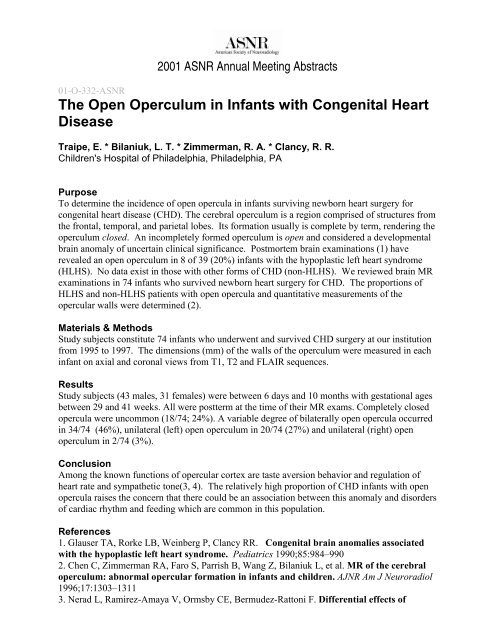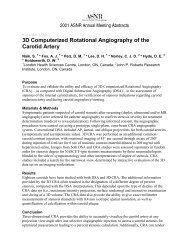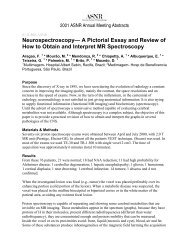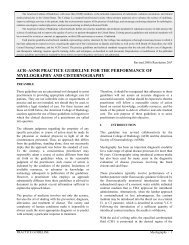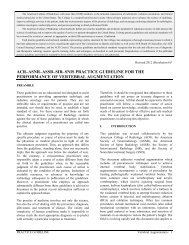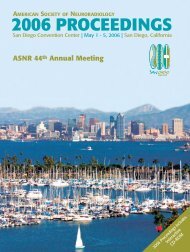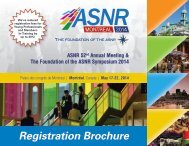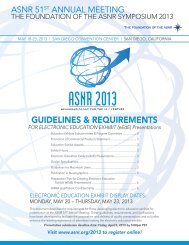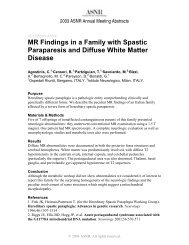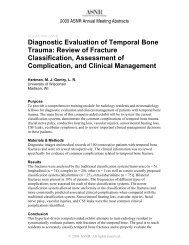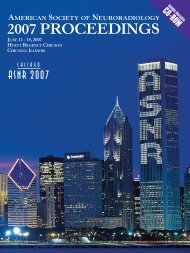The Open Operculum in Infants with Congenital ... - For Members
The Open Operculum in Infants with Congenital ... - For Members
The Open Operculum in Infants with Congenital ... - For Members
Create successful ePaper yourself
Turn your PDF publications into a flip-book with our unique Google optimized e-Paper software.
2001 ASNR Annual Meet<strong>in</strong>g Abstracts<br />
01-O-332-ASNR<br />
<strong>The</strong> <strong>Open</strong> <strong>Operculum</strong> <strong>in</strong> <strong>Infants</strong> <strong>with</strong> <strong>Congenital</strong> Heart<br />
Disease<br />
Traipe, E. * Bilaniuk, L. T. * Zimmerman, R. A. * Clancy, R. R.<br />
Children's Hospital of Philadelphia, Philadelphia, PA<br />
Purpose<br />
To determ<strong>in</strong>e the <strong>in</strong>cidence of open opercula <strong>in</strong> <strong>in</strong>fants surviv<strong>in</strong>g newborn heart surgery for<br />
congenital heart disease (CHD). <strong>The</strong> cerebral operculum is a region comprised of structures from<br />
the frontal, temporal, and parietal lobes. Its formation usually is complete by term, render<strong>in</strong>g the<br />
operculum closed. An <strong>in</strong>completely formed operculum is open and considered a developmental<br />
bra<strong>in</strong> anomaly of uncerta<strong>in</strong> cl<strong>in</strong>ical significance. Postmortem bra<strong>in</strong> exam<strong>in</strong>ations (1) have<br />
revealed an open operculum <strong>in</strong> 8 of 39 (20%) <strong>in</strong>fants <strong>with</strong> the hypoplastic left heart syndrome<br />
(HLHS). No data exist <strong>in</strong> those <strong>with</strong> other forms of CHD (non-HLHS). We reviewed bra<strong>in</strong> MR<br />
exam<strong>in</strong>ations <strong>in</strong> 74 <strong>in</strong>fants who survived newborn heart surgery for CHD. <strong>The</strong> proportions of<br />
HLHS and non-HLHS patients <strong>with</strong> open opercula and quantitative measurements of the<br />
opercular walls were determ<strong>in</strong>ed (2).<br />
Materials & Methods<br />
Study subjects constitute 74 <strong>in</strong>fants who underwent and survived CHD surgery at our <strong>in</strong>stitution<br />
from 1995 to 1997. <strong>The</strong> dimensions (mm) of the walls of the operculum were measured <strong>in</strong> each<br />
<strong>in</strong>fant on axial and coronal views from T1, T2 and FLAIR sequences.<br />
Results<br />
Study subjects (43 males, 31 females) were between 6 days and 10 months <strong>with</strong> gestational ages<br />
between 29 and 41 weeks. All were postterm at the time of their MR exams. Completely closed<br />
opercula were uncommon (18/74; 24%). A variable degree of bilaterally open opercula occurred<br />
<strong>in</strong> 34/74 (46%), unilateral (left) open operculum <strong>in</strong> 20/74 (27%) and unilateral (right) open<br />
operculum <strong>in</strong> 2/74 (3%).<br />
Conclusion<br />
Among the known functions of opercular cortex are taste aversion behavior and regulation of<br />
heart rate and sympathetic tone(3, 4). <strong>The</strong> relatively high proportion of CHD <strong>in</strong>fants <strong>with</strong> open<br />
opercula raises the concern that there could be an association between this anomaly and disorders<br />
of cardiac rhythm and feed<strong>in</strong>g which are common <strong>in</strong> this population.<br />
References<br />
1. Glauser TA, Rorke LB, We<strong>in</strong>berg P, Clancy RR. <strong>Congenital</strong> bra<strong>in</strong> anomalies associated<br />
<strong>with</strong> the hypoplastic left heart syndrome. Pediatrics 1990;85:984–990<br />
2. Chen C, Zimmerman RA, Faro S, Parrish B, Wang Z, Bilaniuk L, et al. MR of the cerebral<br />
operculum: abnormal opercular formation <strong>in</strong> <strong>in</strong>fants and children. AJNR Am J Neuroradiol<br />
1996;17:1303–1311<br />
3. Nerad L, Ramirez-Amaya V, Ormsby CE, Bermudez-Rattoni F. Differential effects of
anterior and posterior <strong>in</strong>sular cortex lesions on the acquisition of conditioned taste aversion<br />
and spatial learn<strong>in</strong>g. Neurobiol Learn<strong>in</strong>g Memory 1996;66:44–50<br />
4. Oppenheimer S. <strong>The</strong> anatomy and physiology of cortical mechanisms of cardiac control.<br />
Stroke 1993;24:I3–15


